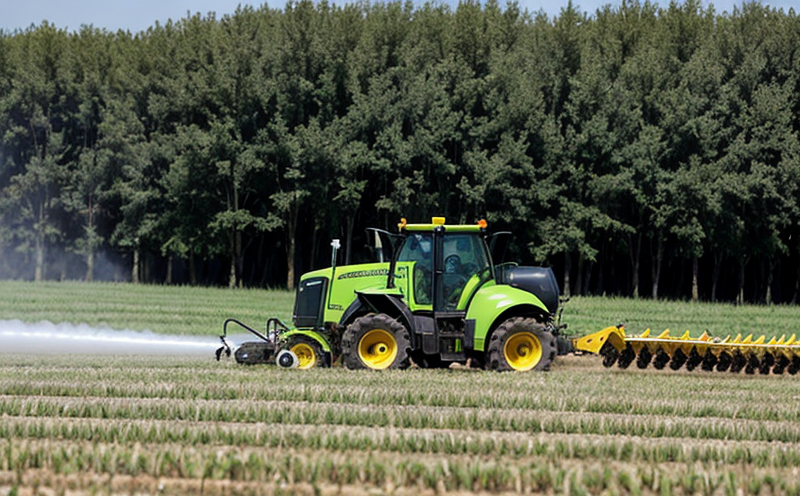Cyprodinil Residue Testing in Crops
Cyprodinil is a broad-spectrum fungicide used to control diseases caused by Botrytis cinerea, Rhizoctonia solani, and other fungi. Its efficacy against fungal pathogens has made it an important tool for agricultural producers globally. However, the presence of residues in crops after application can raise concerns about human health and environmental safety. This article focuses on the testing methods used to quantify cyprodinil residues in various crops.
Residue testing is critical to ensure compliance with legal limits set by regulatory authorities such as the European Food Safety Authority (EFSA) and the U.S. Environmental Protection Agency (EPA). These regulations aim to protect public health and the environment from potential risks associated with pesticide residues in food products.
The analytical methods for detecting cyprodinil residues typically involve high-performance liquid chromatography (HPLC), gas chromatography-mass spectrometry (GC-MS), or liquid chromatography-tandem mass spectrometry (LC-MS/MS). These techniques provide precise and accurate results, which are essential for regulatory compliance.
Before testing can begin, proper sample preparation is crucial. This process involves selecting representative samples from different parts of the crop—roots, stems, leaves, and fruits—and ensuring they are free from contamination. The samples must be dried, ground to a fine powder, and then extracted using solvents such as methanol or acetonitrile.
The extract is then purified through various steps including filtration and cleanup procedures designed to remove interfering compounds. Once prepared, the sample is ready for analysis by the chosen analytical method. The results of these analyses are compared against established limits set forth by relevant regulatory bodies.
Understanding the significance of cyprodinil residue testing extends beyond just meeting legal requirements; it also plays a vital role in maintaining consumer trust and ensuring sustainable agricultural practices. By adhering to strict guidelines during application, monitoring levels post-application, and conducting thorough residue tests, farmers contribute significantly towards creating safer food products.
| Method Name | Principle of Operation | Advantages | Disadvantages |
|---|---|---|---|
| High-Performance Liquid Chromatography (HPLC) | Separates components based on differences in partitioning between a mobile phase and stationary phase. | Precise, cost-effective | Limited sensitivity compared to other methods. |
| Gas Chromatography-Mass Spectrometry (GC-MS) | Combines GC with MS for enhanced detection capabilities. | Sensitive, versatile | Expensive equipment required. |
| Liquid Chromatography-Tandem Mass Spectrometry (LC-MS/MS) | Combines LC with MS for even greater sensitivity and selectivity. | Highest level of accuracy, widely used in forensic science. | Complex setup; requires skilled personnel. |
The choice between these methods depends on factors like budget constraints, required precision levels, and the types of samples being analyzed. For instance, LC-MS/MS is preferred when dealing with complex matrices due to its superior ability to differentiate closely related compounds.
It’s important to note that while cyprodinil itself is not considered carcinogenic by many regulatory bodies, excessive exposure could still pose risks depending on the level and duration of contact. Therefore, regular monitoring through rigorous testing procedures ensures compliance with safety standards.
Industry Applications
| Crops | Application Notes |
|---|---|
| Oranges and Lemons | Testing ensures no residues remain after harvest to protect consumers. |
| Grapes | Prevents contamination during fermentation processes. |
| Eggplants | Reduces risk of residue transfer from plant to produce. |
| Corn and Maize | Avoids issues related to mycotoxin production caused by fungal infections. |
In addition to food crops, cyprodinil residue testing is also crucial for ornamental plants used in landscaping projects. Proper testing helps ensure that any potential residues do not affect the quality or safety of these plants when they are sold commercially.
Why Choose This Test
Selecting reliable laboratories for conducting cyprodinil residue tests is crucial due to their direct impact on regulatory compliance and consumer confidence. Our laboratory offers comprehensive services tailored specifically towards meeting industry standards, ensuring accurate results every time.
We utilize state-of-the-art equipment operated by highly qualified professionals who maintain strict adherence to international protocols such as ISO 17025:2017. This accreditation guarantees that our methods meet the highest quality assurance criteria recognized worldwide.
The importance of accurate residue testing cannot be overstated, especially considering increasing public scrutiny regarding agricultural practices and food safety issues. By choosing us, you gain access to expert advice and support throughout your project lifecycle—from initial consultation through final reporting.
We pride ourselves on delivering timely reports that are not only precise but also easy to understand, making it simple for stakeholders at all levels within an organization to make informed decisions based on our findings.
International Acceptance and Recognition
Cyprodinil residue testing is widely recognized across numerous countries. Regulatory agencies like the European Union (EU), United States Department of Agriculture (USDA), and others have established guidelines for allowable limits in different crops.
The EU, for example, specifies maximum residue levels (MRLs) for various fruits, vegetables, and other produce based on the type of crop and country where it was grown. Similarly, USDA maintains its own set of MRLs which vary depending upon factors such as soil conditions, climate zones, etc.
Our laboratory ensures compliance with these international standards through rigorous quality control measures implemented at every stage of our testing process. This commitment to excellence allows us to provide accurate results that meet or exceed the expectations of regulatory bodies globally.





